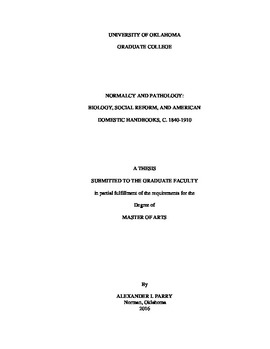| dc.description.abstract | This article examines the relationships between the biological and social content of the domestic handbooks Catharine E. Beecher (1800-1878) and Charlotte Perkins Gilman (1868-1935) wrote during the mid-nineteenth and early-twentieth centuries. The article concentrates specifically on The American Woman’s Home (1869), Women and Economics (1898), and The Home: Its Work and Influence (1903) and submits that contemporary biological science not only helped Beecher and Gilman uphold their proposed sociocultural reforms but also shaped their recommendations for the status and responsibilities of American women. Whereas Beecher supported the doctrine of separate spheres and the stable norm of the single-family, middle-class, Protestant household using cell theory and germ theory, Gilman claimed mothers should enter the workforce and hire trained professionals for their domestic labor using the Darwinian theories of adaptive variation and sexual selection. The domestic publications of Beecher and Gilman therefore construct two different scientific ideologies for their respective sociocultural platforms and extend descriptive scientific facts into the realm of prescriptive social reform.
This project draws upon the theories of normalcy and pathology from Georges Canguilhem and Michel Foucault and claims the scientific ideologies of Beecher and Stowe advance completely different definitions of normalcy, abnormality, health, and pathology. While the first chapter of this article explains the history of domestic handbooks and charts the interplay between science and culture, the second and third chapters examine the separate biological concepts and cultural reforms Beecher and Gilman advanced during their lifetimes. This study includes the following subjects: motherhood, childhood education, community architecture, legitimate occupations for men and women, domestic economy, cell theory, early germ theory, miasma theory, Darwinian evolution, and sexual selection. The article concludes that researchers should not only study the rhetorical effectiveness of scientific discourse but also explore how specific biological schemes of normalcy and pathology set parameters for rational social policy. | en_US |
